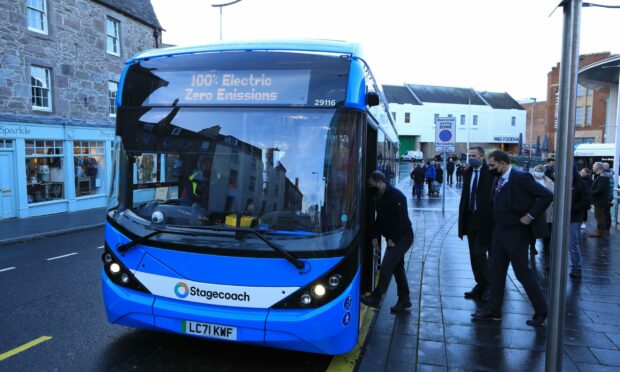The future of bus travel in Scotland is under the microscope after wealthy bus companies received “eye-watering” sums to go electric.
East coast market leader Stagecoach has announced plans to run an all electric service in Perth and Inverness from early 2023. That’s after receiving more than £24 million from a £62 million pot in subsidy from the Scottish Government.
That works out at more than £226,000 per bus.
The scheme was oversubscribed to the tune of £12m. Ministers initially flagged £50m would be available.
Some see the Perth-based Stagecoach announcement as the death knell of the diesel bus. Other companies, such as Xplore Dundee, are also heavily promoting their electric fleets.
But the sums involved have raised eyebrows and provoked some anger.
Especially given Stagecoach’s operating profit rose from £48.1m last year to £72.7m in the latest financial year.
Scottish Labour Transport spokesperson Neil Bibby MSP said: “We can’t keep handing more and more money over to private bus companies while they slash services and rack up profits.”
Bus companies struggling to deliver services
Everyday services, meanwhile, appear to be at an all-time low as Stagecoach and Xplore Dundee struggle to recruit and retain enough drivers to deliver key services.
That has led to a slew of cancelled services and new timetables delivering fewer services with passengers in Perth and Dundee feeling the brunt.
Elderly passengers have called The Courier to talk about being left waiting for hours at bus stops in Perth for buses that fail to materialise.
Yet transport remains the leading cause of carbon emissions – and the hardest to cut – leading many to believe large subsidies direct to operators are a crucial tool in driving much-needed change.
Electric bus funding pays for difference in cost to diesel vehicle
Colin Howden is the director of sustainable transport alliance Transform Scotland.
He said “It’s really a case of when, not if, diesel buses are phased out.
“We’d expect diesel bus fleets to be replaced by more sustainable fuel sources such as electricity and hydrogen for almost all applications.”
Colin highlighted the challenge around the costs of electric busses. They vary on size and model but can come in for around £400,000 with a diesel equivalent roughly £180,000 cheaper.
The Scottish Government’s Zero Emission Bus Challenge Fund (ScotZEB) allowed bus companies to apply for electric bus funding. That could cover the entire difference, as well as associated infrastructure costs.
Stagecoach received £24,261,338 from the fund. That’s enough to buy 6,384,562 day rider tickets in Perth at £3.80 each.
Bus companies then benefit from significantly reduced running costs, although many units will require an expensive battery replacement around seven years into their working lives.
Colin continues: “There’s been a reliance on government subsidy to encourage the earlier take-up of sustainable alternatives.
“But as electric becomes the norm across new additions to the bus fleet, we’d expect to see bus manufacturers gradually phasing out diesel options leading to diesel buses not being an option for operators.”
Electric bus funding for Fife, Dundee as well as Perth
Stagecoach has bold ambitions to decarbonise its services through electric buses.
One electric double-decker, seven single deckers and five midibuses of around 28 seats will add to existing services in Perth.
While Fifers will not miss out. One e-double decker and 10 midibuses will work out of Dunfermline soon, driving the electric revolution in the Kingdom.
In Dundee, Xplore has focused its electric services on Lochee Road, one of the most polluted streets in Scotland. Currently all 12 electric buses serve the 28 route through the city.
Xplore’s parent company McGill’s received more than £9 million from the fund.
Invergowrie Labour councillor Alasdair Bailey is pleased the electric investment will benefit passengers in Perth.
“Undoubtedly, electric traction has to be the way forward for public transport. Removing emissions and noise from busy city streets will greatly improve the environment for those who live, work and shop in town.”
But he added the “public money awarded to Stagecoach to fund these buses is an eye-watering amount.”
“Especially given that their profits are over three times that amount.
“However, I accept that some level of subsidy is likely needed to ‘prime the pump’. It shows electric-powered buses can be a viable part of a commercial fleet for a company like Stagecoach.”
Lower electric bus funding in 2023
Labour Transport spokesperson Neil continued: “Far too many Scots can’t catch a bus at all – never mind an electric one.
“Green transport in Scotland is crying out for investment, but the SNP need to do more than write cheques for large private bus companies.
“They need to help councils run and regulate their own green bus services, instead of relying on this sticking plaster approach.”
Far too many Scots can’t catch a bus at all.”
– Neil Bibby, Labour Transport spokesman.
A Transport Scotland spokesman defended the scheme.
He said the first phase of ScotZEB supported “swift, and significant, change in the bus market in favour of zero-emission technologies”.
He said all bids were assessed against community benefit, air quality and financial criteria.
“Bus is currently one of the greenest and cleanest transport choices a person can make.
“The Scottish Government intends to ensure it remains that way by working with the sector to decarbonise at pace,” he added.
The first phase of the ScotZEB scheme has closed. Ministers have already said less direct subsidy will be available when it returns in 2023.
The Scottish Government is currently operating a far more modest £500,000 scheme to support smaller operators into delivering electric services.
Meanwhile, a Stagecoach spokesperson defended its application for support. She pointed out the Scottish Government offered the scheme to all bus operators based on its own criteria.
But at least until services return to an acceptable standard, many passengers will continue to question the Scottish Government’s decision to hand struggling bus companies such significant sums of money.















Conversation